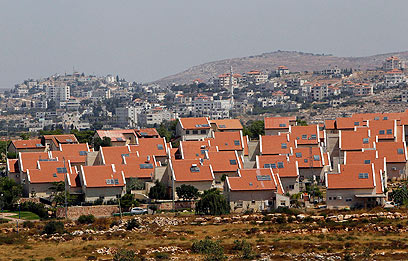
Report: Investment in settlements higher
Government transfers to in territories in 2009 were three times higher than grants given to local authorities within Green Line, Adva Center says. State responsible for 50% of building starts in settlements, compared to only 18% within Israel
The figures show that the scope of balance grants transferred by the government to local authorities in the territories was three times higher than the balance grants given to local authorities within Israel and 1.5 times higher than the balance grants transferred to development towns.
Related stories:
The balance grants are large sums of money the government transfers to local authorities to balance their budget deficit. Although these grants have been significantly reduced in the past decade, they still make up 5% of local authorities' average income.
According to the Adva Center report, in 2009 the State transferred NIS 2.1 billion (about $570 million) to the local authorities. An average of NIS 303 ($83) per capita was transferred to each local authority within the Green Line (excluding Judea and Samaria and the Golan Heights), while settlements received an average of NIS 951 ($260) per capita.
The average in Arab communities stands at NIS 776 ($212) per capita, and the average in development towns totals NIS 616 ($168) per capita.

Settlement of Ofra (Photo: Reuters)
The government's balance grants are given in accordance with the local authority's economic situation, which affects its ability to earn an income. The drop in the scope of balance grants in the past decade reflects a gradual increase in local authorities' income, which rose from NIS 2.1 billion ($570 million) in 2000 to NIS 27.7 billion ($7.5 billion) in 2009.
The independent income of local authorities in the territories in 2009 stood at NIS 2,523 ($690) per capita, less than half the income per capita in cities belonging to the "15 well-established cities" forum, which do not receive any balancing grants and fund all services from their income.
Rise in haredi cities' population
The large gaps in the local authorities' income also stem from their residents' socioeconomic status, but also from the scope of aid they receive from the government, which makes it unnecessary to collect taxes and impose fees and fines.
The low income of local authorities in the settlements can be ascribed to the increasing growth in the population of the ultra-Orthodox cities, Modiin Illit and Beitar Illit, whose population made up 28% of the settler population at the end of 2009.
A wide gap between the government investment in Judea and Samaria and its investment in communities across Israel is also apparent in the construction field. According to the Adva Center report, the trend which led to the housing crisis in Israel did not skip the settlements, which also recorded a drop in construction in the past decade.
Nonetheless, the figures on the scope of the government's participation point to a worrying gap in the list of priorities, especially on the backdrop of the housing protest. It turns out that the State has money to invest in construction, when it comes to a party ideology.
The construction of 20,933 apartments in Judea, Samaria and Gaza began from 2000 to 2009, at a total investment of NIS 14.4 billion ($4 billion). Half of the apartments built were initiated by the government.
The State was responsible for some 50% of building starts and some 35% of the total investment in housing construction in the territories, while within Israel the State was responsible for only 18% of building starts and 10% of the total investment in housing construction.
- Follow Ynetnews on Facebook










